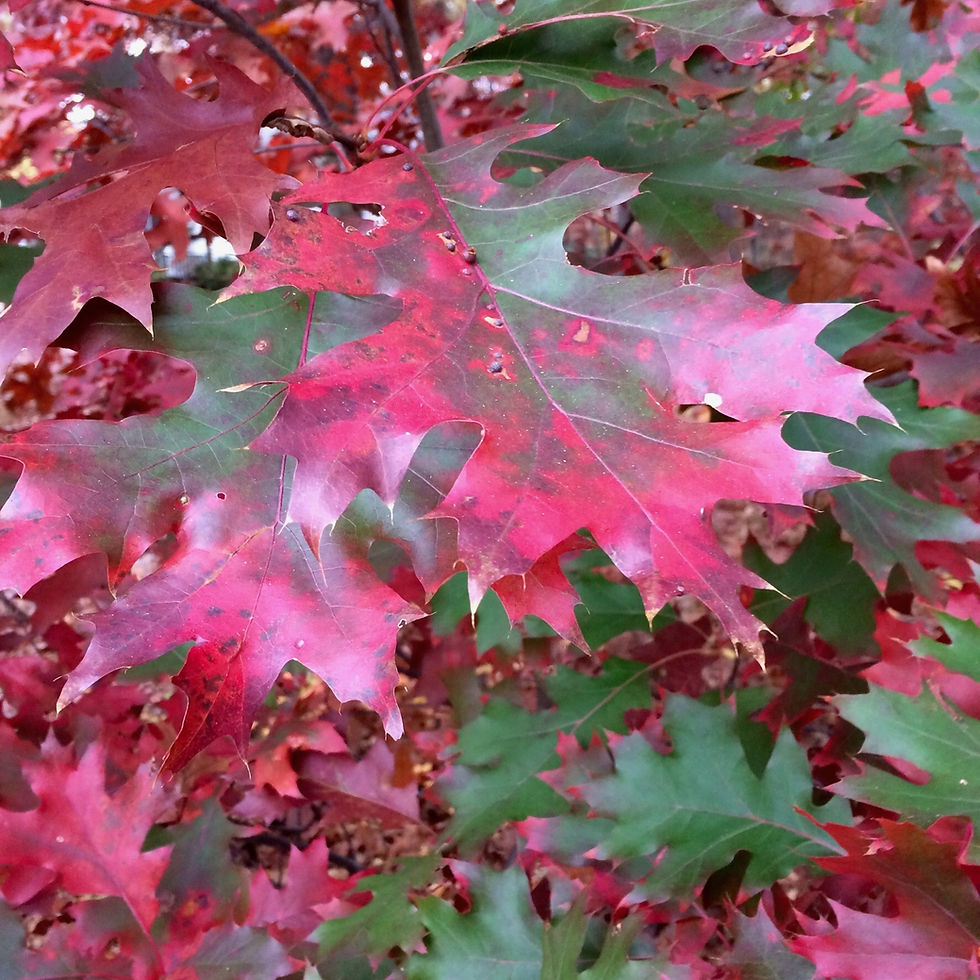Garden Obstacles: Wildlife Shrubs & Trees for Smaller Spaces
- Kimberly Simmen
- Dec 3, 2023
- 7 min read
Choosing trees and shrubs to attract wildlife is not an easy task as many of our native trees are just too big for residential gardens. It would be amazing if we all had room for a majestic white oak (Quercus alba), beautiful black oak (Quercus velutina), or the delicious black walnut (Juglans nigra), but many do not. You still have plenty of choices to attract wildlife into your yard. Here's a list of some smaller native trees and shrubs to fit any niche. These are all native to Long Island.
Quercus ilicifolia (Scrub Oak) Tree
This small oak rarely gets taller than 15' but may reach 25' if in full sun without any competition from other trees. It has a whimsical silhouette due to its contorted trunk. Catkins (flowers) appear in early spring and of all the oaks, I think it's the showiest one. Female and male flowers are on the same tree (monoecious) and are wind-pollinated. In fall the foliage turns a lovely reddish purple. Scrub Oak prefers full sun and dry, sandy, acidic soil. It does not tolerate any shade. The acorns are a food source for turkey, grouse, songbirds, woodpeckers, squirrels, and many more. It is a host plant to many insects for foraging birds to consume. Some of the insects it supports include the caterpillars of many moth and butterfly species.

Photo: flower (Dave LaMagna)
Salix humilis (Prairie Willow) Shrub
This dry to moist soil-loving willow usually doesn't grow taller than 6', but if it is very happy, it may reach 8' tall and 6-8' wide. Prefers full sun to partial sun. It is a very early bloomer and a magnet for early spring native pollinators. It is a host plant to several moth and butterfly caterpillars as well as other insects that birds eat. Birds also use willow thickets as cover and for nesting sites. Prairie willow is the slowest growing of all the willows and may be cut back every few years to keep it fresh and on the shorter side.

Photo: flower (R.W. Smith)
Cornus racemosa (Gray Dogwood) Shrub
One of my absolute favorites, especially as an understory planting! Gray Dogwood prefers sun to deep shade and is quite adaptable to many types of soil conditions from wet to dry. This thicket-forming beauty grows to about 10-20' tall with a 10-15' spread. Like other native shrubs, it may be hedged to control the height. The suckers are easily removed with a sharp spade shovel. The spreading habit is what makes it a great place for birds to take cover and nest. The white flowers in spring attract butterflies, bees, small pollinating beetles, and beneficial predatory insects that prey on pests. The white berries that follow in late summer are relished by cardinals, downy woodpeckers, northern flickers, eastern bluebirds, squirrels, chipmunks, and raccoons. It is the host plant for the spring azure butterfly. A bonus is the lovely reddish-purple fall foliage. Needless to say, the bark is gray but attractive. It is a true three-season interest shrub. Unfortunately, it may be nibbled by deer and rabbits.
Photos: flower, unripe berries, ripe berries
Prunus maritima (Beach Plum) Tree
Here's a tree that brings me back to my childhood. My grandma used to make beach plum jelly from the beach plums collected at Long Beach in St. James, NY. So yummy! This small tree, growing usually 6-8' tall (rarely reaches 10' tall) with a 6-8' spread, prefers full sun and dry to moist, well-drained soil. The white flowers appear in May and are followed by delicious, edible purplish fruit in August-September. The beach plum has what we call perfect flowers meaning male and female reproductive parts are present in each flower. Two plants are needed for cross-pollination, which will give you a higher fruit yield. It is tolerant of drought, and salt (sea and road) and is usually deer-resistant. It is a host plant to the many Lepidoptera species including the coral hairstreak, eastern tiger swallowtail, red-spotted purple, striped hairstreak butterflies, and dozens of moths. Songirds also love the fruit as much as we do.

Photo: flower
Cercis canadensis (Eastern Redbud) Tree
This beautiful understory tree in the pea family grows 20-30' tall by 25-35' wide. It is a moderately fast grower putting on 1-2' per year. It prefers full sun to partial shade and moist, well-drained soil. It will even tolerate clay soil. The purple-pink flowers bloom in the spring before the adorable heart-shaped leaves emerge. The pendulous seed pods are also quite attractive and songbirds and other small mammals love to eat them. Another plus is it will grow under black walnut trees as it is not bothered by the juglone in the soil. It hosts twelve species of Lepidoptera including Henry's Elfin butterfly. Eastern Redbud also brings in specialized native bees and our cute little leafcutter bees.

Photo: bud and bark
Acer pensylvanicum (Striped Maple) Tree
This fantastic understory maple prefers partial to full shade. It grows 15-25' tall by 12-20' wide and prefers average to moist but well-drained soil. Showy yellow flowers bloom in early spring and develop into a chain of winged samaras. Leaves emerge pink, develop to green, and turn brilliant yellow in the fall. It has a few common names; one is snakebark maple referring to the young bark that has white striped markings, and the other is goosefoot maple referring to the shape of the leaves. It is browsed by many mammals. Striped Maple is host to 297 species of Lepidoptera and a fantastic nectar tree for early pollinators.
Photos: flower (J.K. Marlow), samaras (Homer Edward Price), young bark
Amelanchier canadensis (Serviceberry) Shrub
This underutilized three-season beauty brings light to shady spots. It is an early spring bloomer with fragrant, clear white flowers. These flowers turn to green berries that mature to crimson to finally dark purple in June. If you are lucky the birds will save you a few. They make a fine jelly or jam. This multistemmed shrub or small single-trunked tree grows 6-25' tall with an equal spread. Preferring average to moist but well-drained soil in partial shade (morning sun) to dappled sunlight. I have also found it tolerates a decent amount of drought in the shade. The fall color is a bright orange to rusty red. It holds special value for our native bees and is a host plant for 15 species of Lepidoptera including red-spotted purple and viceroy butterflies.

Photo: flower
Aronia melanocarpa (Black Chokeberry) Shrub
Another beautiful multistemmed shrub with white flowers in May followed by edible black fruits. It is not very tasty right off the shrub, but it makes a great jam and jelly. Growing 3-10' tall and 3-6' wide it prefers full sun to partial shade and dry to wet soils. It will also tolerate clay soil. Aronias are self-pollinating but will have better fruit yield with more than one is planted. The fall color is a bright red-burgundy, rivaling that of the invasive Euonymus alata (burning bush). Unfortunately, it is nibbled by deer and rabbits. Flowers are a great early nectar source for our early pollinators and the fruit is enjoyed by songbirds. Another tidbit is it is being touted as the new superfruit!

Photo: flower with an early pollinator
Carpinus caroliniana (American Hornbeam) Tree
Another one of my absolute favorites! This beauty grows 20-35' tall and wide. It prefers partial to full shade and average to moist soil. It will also grow under black walnut trees as it is not bothered by the juglone in the soil and is quite drought tolerant. Male and female catkins are found on the same tree in spring. The flowers are followed by nutlets in the fall and enjoyed by our songbirds and small mammals. Fall color is delightful as it goes from yellow to orange to red. This beauty may also be pruned into a hedge. It is a host plant for the eastern tiger swallowtail and red-spotted purple butterflies.

Photo: summer leaves
Lindera benzoin (Spicebush) Tree
Another underutilized large shrub/small tree but it is making its way back into residential yards! The fragrant yellow flowers open in April before the leaves appear. Growing 8-15' tall and equally wide, it prefers sun to partial shade and moist but well-drained soil. It is quite adaptable to drought. Another plus is it will grow under black walnut trees as it is not bothered by the juglone in the soil. The fall color is a nice golden yellow. Male and female flowers are born on separate plants, but they are not sexed in the trade, so don't ask for males and females. If you are lucky enough to get a female and a male you will have scarlet red fruit in August through September. It is the host plant to the spicebush swallowtail butterfly and the Promethea silkmoth.
Photo: caterpillar, fall chrysalis
Hamamelis virginiana (Common Witch Hazel) Shrub
This underused shrub has its fruits and flowers appearing at the same time. This is a very unusual feature. The fragrant strappy yellow flowers appear in the late fall to winter. At this time it is also releasing its seeds! The flowers are pollinated by noctuid moths (owlet moths). It grows 15-20' tall and equally wide and prefers sun to partial shade in average to moist soil. It also tolerates clay soil. The yellow fall color is quite attractive. It hosts 62 species of Lepidoptera species. Songbirds love the seeds.
Photo: buds with fall leaf color, flowers after leaf drop, summer foliage
Ilex verticillata (Winterberry) Shrub
Winterberry is a must-have in the yard. Its small green flowers are relished by early pollinators in spring. Growing 5-12' tall with an equal spread, it prefers moist to wet but well-drained soil. It tolerates clay soil too. This is a great shrub for shady spots as it will grow in full sun to deep shade. Even better, it is tolerant of heat, drought, and soil compaction. The red fruit is enjoyed by over 40 species of birds in mid to late winter. You will need a male to produce berries on the female plants. One male for every 15-20 females is a good ratio if he is planted within 40' of the ladies. 'Jim Dandy', 'Southern Gentleman', and the straight species (male) are the boys that work for this lovely lady. It is the host plant for Henry's Elfin butterfly.
Photo: berries in winter, female flower in spring, berries in fall before leaf drop
Of course, there are many more options but I picked some of my favorites. I hope this helps you choose a great native tree or shrub for your property. Remember, no matter how big or small, every native plant counts!
Sources:
Manual of Woody Landscape Plants by Michael A. Dirr, rev. 2009, Stipes Publishing
New York Flora Atlas, https://newyork.plantatlas.usf.edu
North Carolina Extension Gardener Plant Toolbox, https://plants.ces.ncsu.edu/find_a_plant/
Nature's best hope: A new approach to conservation that starts in your yard by D.W. Tallamy, 2020, Workman Pub Co.
Photos: KMS Native Plants except where noted







































Comments